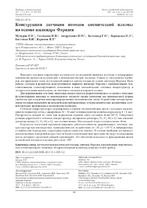Конструкция датчиков потоков космической плазмы на основе цилиндра Фарадея

Authors
Date
2017Publisher
Another Title
The design of the solar wind ion flux sensors based on the Faraday cup
Bibliographic entry
Конструкция датчиков потоков космической плазмы на основе цилиндра Фарадея = The design of the solar wind ion flux sensors based on the Faraday cup / Мухуров Н. И. и др. // Приборы и методы измерений : научно-технический журнал. - 2017. – Т. 8, № 4. – С. 305-313.
Abstract
Важными задачами современных космических исследований являются изучение и непрерывные наблюдения процессов космической и метеорологической «погоды». Одним из электронных приборов для проведения таких исследований является датчик плазмы на основе цилиндра Фарадея. Цель работы состояла в разработке конструктивного варианта цилиндра Фарадея с прецизионными чувствительными (селектирующими) элементами в виде металлических сеточных микроструктур и четырехсекторным коллектором, не имеющего аналогов в мировой технике. Для формирования сеточных никелевых микроструктур разработан процесс создания с помощью фотолитографии матрицы из нанопористого анодного оксида алюминия как прецизионной формы (шаблона) для осаждения наноструктурированных металлических слоев. Разработаны методы проведения тестовых испытаний на механические (вибрационные) и термоциклические воздействия, соответствующие требованиям к космическим приборам. Сеточные микроструктуры сформированы в едином технологическом цикле с кольцами-держателями по периметру сетки, с квадратным 20 × 20 мкм² сечением полотна и ячейками размером 1 × 1 мм². Прозрачность каждой из сеток при нормальном падении света составила более 90 %. Габаритные размеры держателей и сеточных микроструктур: внутренние диаметры (34, 47, 60) ± 0,1 мм, внешние диаметры колец (42, 55, 68) ± 0,1 мм соответственно. Масса одной сетки составила менее 50 мг. Результаты испытаний продемонстрировали работоспособность разработанных сеточных микроструктур при многократных термоциклических воздействиях от –50 до +150 °С и вибрационных и статических перегрузках, характерных при космических полетах. В составе приборов для проведения плазменных измерений в окрестности Земли и в межпланетном пространстве будут использованы шесть датчиков с различной угловой ориентацией. Это обеспечит возможность фиксирования ионов космической плазмы в телесном угле около 180°.
Abstract in another language
Important tasks of modern space research are the study and continuous observations of the processes of cosmic and meteorological «weather». One of the electronic devices for carrying out such researches is a plasma sensor based on Faraday cup. The purpose of the work was to develop a constructive variant of the Faraday cup with precision sensitive (selective) elements in the form of metal grid microstructures and a foursector collector, which has no analogues in the world technology. For the formation of grid nickel microstructures, a process has been developed for creating a matrix of nanoporous anodic aluminum oxide by photolithography as a precision shape (template) for depositing nanostructured metal layers. Methods for conducting testing for mechanical (vibrational) and thermocyclic impact that satisfies the requirements for space instruments have been developed. The grid microstructures are formed in a unified technological cycle with the production of ring-holders along the perimeter of the grid, with a square 20 × 20 μm² section of the web and square cells with a size of 1 × 1 mm². The transparency of each of the grids was more than 90 % for the normal incidence of light. Dimensions of holders and grid microstructures: internal diameters (34, 47, 60) ± 0. 1 mm, external diameters of rings (42, 55, 68) ± 0. 1 mm, respectively. The weight of one grid was less than 50 mg. The test results demonstrated the operability of the developed grid microstructures with multiple thermocyclic actions from –50 to +150 °C and vibrational and static overloads specific for space flights. Instruments for plasma measurements in the near of the Earth and in the interplanetary space will comprise six sensors with different angular orientations. This will make it possible to detect ions of cosmic plasma in a solid angle of about 180°.
View/
Collections
- Т. 8, № 4[10]
